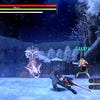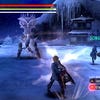Gods Eater Burst
Aragami Killer.
This month marks the seventh anniversary of the first Monster Hunter title. Released six months before World of Warcraft, it's a game which shares the MMO's focus on co-operative gameplay.
But when it comes to popularity, World of Warcraft has taken off in the west like a Pez dispensing yo-yo with a built in Tamagotchi - while Monster Hunter has failed to set the world outside of Japan alight.
Both series also share a similar lineage, but while WOW has fought off countless would-be rivals, Monster Hunter had a only few challengers to contend with - such as Phantasy Star Portable and Lord of Arcana.
Until now, that is. Because now, Namco Bandai has teamed up with Shift, the developer behind Devil Dice, to bring us a genuine alternative.
They say imitation is the sincerest form of flattery, a thought which the Monster Hunter team may want to comfort itself with on seeing God Eater (as it is known in Japan).
But while this game borrows liberally from Capcom's template – once again you build better equipment from the component parts of your dead enemies – God Eater offers an experience that is less daunting and more accessible. It even comes complete with a sci-fi story which plays out like a run-of-the-mill anime.
"Compared to Monster Hunter, the missions in God Eater are more condensed."
The God Eater world has become infected with a microscopic organism which can assimilate all known matter. If enough of these cells pool together, they form constructs known as "Aragami" which are hell-bent on destroying humanity.
As such, civilisation has been brought to its knees by an army of nightmare creatures. In a last ditch attempt to avoid extinction, an organisation called Fenrir is set up to fight the Aragami menace.
This is just an elaborate ruse for trendy teenagers to carry lamppost sized weaponry while battling armoured scorpions and demonic denizens. But as a change of pace from the talking cats and tribal towns, God Eater offers an urban landscape set in a dystopian future.
And while the story is told via the medium of woeful voice acting – which makes the ropey plot even more forgettable – it at least offers a cool down period between bouts of grinding.
First time players will need to sculpt their own God Eater in the single-player mode before considering the ad-hoc multiplayer, once they have a few hours under their belt.
Character creation is basic, with less than 20 hairstyles available for either gender, but if you've always wanted to play as a guy who wears a bandana over one eye or a girl who never takes off her headphones – not even during an important briefing – then God Eater caters for your role-playing needs.
Once this formality is out of the way you'll then be inducted at a central hub which provides all the God Eater amenities. It's in this small area that you'll upgrade your weapons, craft new items and speak to the cast of NPCs – who usually offer a bit of colour and advice – before talking to the mission clerk to see what jobs are available. The 100-plus missions are then split between ten Ranks, with difficulty increasing as you progress through the story.
Compared to Monster Hunter, the missions in God Eater are more condensed. The maps are considerably smaller, there are no loading times between sections and your objective is always to kill.
You still gather resources, but rather than using breakable tools to harvest from a believable ecosystem you simply revisit the same locations, then press circle for your character to crouch down and pocket a random item. It's entirely hassle-free but lacks the subtle splendour which makes Monster Hunter so compelling.
This streamlining also branches into a combat system that's similar to Monster Hunter but with less choice and a much faster tempo.





